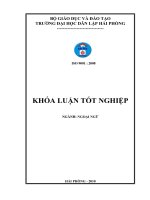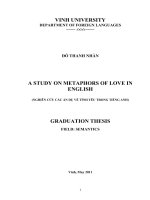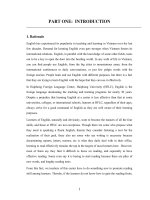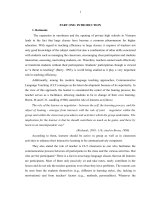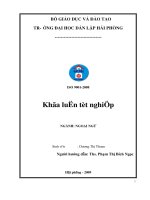A study on words from names in nguyen nhat anh's stories and their english equivalents
Bạn đang xem bản rút gọn của tài liệu. Xem và tải ngay bản đầy đủ của tài liệu tại đây (391.08 KB, 57 trang )
BỘ GIÁO DỤC VÀ ĐÀO TẠO
TRƯỜNG ĐẠI HỌC DÂN LẬP HẢI PHỊNG
-------------------------------
ISO 9001 : 2008
KHĨA LUẬN TỐT NGHIỆP
NGÀNH: NGOẠI NGỮ
HẢI PHÒNG - 2010
HAIPHONG PRIVATE UNIVESITY
FOREIGN LANGUAGES DEPARTMENT
-----------------------------------
GRADUATION PAPER
A STUDY ON WORDS FROM NAMES IN
NGUYEN NHAT ANH’ S STORIES AND THEIR
ENGLISH EQUIVALENTS
By:
PHAM THI NGA
Class:
NA1002
Supervisor:
NGUYEN THI THU HUYEN, M.A.
HAI PHONG – JUNE 2010
BỘ GIÁO DỤC VÀ ĐÀO TẠO
TRƯỜNG ĐẠI HỌC DÂN LẬP HI PHềNG
--------------------------------------
Nhiệm vụ đề tài tốt nghiệp
Sinh viờn: ............................................................Mó s:
............................
Lp:
.............................Ngnh:....................................................................
Tờn đề tài:
.................................................................................................
..............................................................................................
....
..............................................................................................
...
..............................................................................................
....
Nhiệm vụ đề tài
1. Nội dung và các yêu cầu cần giải quyết trong nhiệm vụ đề tài tốt
nghiệp
( về lý luận, thực tiễn, các số liệu cần tính tốn và các bản vẽ).
……………………………………………………………………………..
……………………………………………………………………………..
……………………………………………………………………………..
……………………………………………………………………………..
……………………………………………………………………………..
……………………………………………………………………………..
……………………………………………………………………………..
……………………………………………………………………………..
2. Các số liệu cần thiết để thiết kế, tính tốn.
……………………………………………………………………………..
……………………………………………………………………………..
……………………………………………………………………………..
……………………………………………………………………………..
……………………………………………………………………………..
……………………………………………………………………………..
……………………………………………………………………………..
……………………………………………………………………………..
……………………………………………………………………………..
3. Địa điểm thực tập tốt nghiệp.
……………………………………………………………………………..
……………………………………………………………………………..
……………………………………………………………………………..
CÁN BỘ HƯỚNG DẪN ĐỀ TÀI
Người hướng dẫn thứ nhất:
Họ và tên: .............................................................................................
Học hàm, học vị: ...................................................................................
Cơ quan công tác: .................................................................................
Nội dung hướng dẫn: ............................................................................
Người hướng dẫn thứ hai:
Họ và tên:.............................................................................................
Học hàm, học vị:...................................................................................
Cơ quan công tác:.................................................................................
Nội dung hướng dẫn:............................................................................
Đề tài tốt nghiệp được giao ngày 12 tháng 04 năm 2010
Yêu cầu phải hoàn thành xong trước ngày 10 tháng 07 năm 2010
Đã nhận nhiệm vụ ĐTTN
Sinh viên
Đã giao nhiệm vụ ĐTTN
Người hướng dẫn
Hải Phòng, ngày tháng năm 2010
HIỆU TRƯỞNG
GS.TS.NGƯT Trần Hữu Nghị
PHẦN NHẬN XÉT TÓM TẮT CỦA CÁN BỘ HƯỚNG DẪN
1. Tinh thần thái độ của sinh viên trong quá trình làm đề tài tốt
nghiệp:
……………………………………………………………………………..
……………………………………………………………………………..
……………………………………………………………………………..
……………………………………………………………………………..
……………………………………………………………………………..
……………………………………………………………………………..
……………………………………………………………………………..
……………………………………………………………………………..
2. Đánh giá chất lượng của khóa luận (so với nội dung yêu cầu đã đề ra
trong nhiệm vụ Đ.T. T.N trên các mặt lý luận, thực tiễn, tính tốn số
liệu…):
……………………………………………………………………………..
……………………………………………………………………………..
……………………………………………………………………………..
……………………………………………………………………………..
……………………………………………………………………………..
……………………………………………………………………………..
……………………………………………………………………………..
……………………………………………………………………………..
……………………………………………………………………………..
3. Cho điểm của cán bộ hướng dẫn (ghi bằng cả số và chữ):
……………………………………………………………………………..
……………………………………………………………………………..
……………………………………………………………………………..
Hải Phòng, ngày ….. tháng ..… năm 2010
Cán bộ hướng dẫn
(họ tên và chữ ký)
NHẬN XÉT ĐÁNH GIÁ
CỦA NGƯỜI CHẤM PHẢN BIỆN ĐỀ TÀI TỐT NGHIỆP
1. Đánh giá chất lượng đề tài tốt nghiệp về các mặt thu thập và phân tích tài
liệu, số liệu ban đầu, giá trị lí luận và thực tiễn của đề tài.
2. Cho điểm của người chấm phản biện :
(Điểm ghi bằng số và chữ)
Ngày.......... tháng......... năm 2010
Người chấm phản biện
ACKNOWLEDGEMENTS
From bottom of my heart, I would like to show my deepest gratitude
to many people helping and encouraging me enthusiastically in preparing and
completing the graduation paper.
First of all, I would like to express my heart felt thanks to Ms. Nguyen
Thi Thu Huyen, M.A., my supervisor, who has given me many valuable
guidance, helpful suggestions and advices for my research.
Also, I would like to express my gratitude to Ms. Nguyen Thi Yen
Thoa, M.A., for her help during my completion of the paper.
Next, I am also grateful to all teachers at Haiphong Private University
whose support and advices have improved my study.
Last but not least, I owe sincere thanks to all members of my family
and friends for all they have done for me. Without their support and
encouragement, this graduation paper would not have become reality.
I know my graduation paper still keeping mistakes for my
shortcomings. I would like to receive your comments, suggestions and
corrections for the perfect of my own graduation paper.
Hai Phong, June 2010
Pham Thi Nga
TABLE OF CONTENTS
ACKNOWLEDGEMENT
PART ONE: INTRODUCTION .................................................................. 1
1. Rationale of the study ................................................................................. 1
2. Aims of the study ........................................................................................ 2
3. Methods of the study ................................................................................... 2
4. Scope of the study ...................................................................................... 2
5. Design of the study..................................................................................... 3
PART TWO: DEVELOPMENT ................................................................. 4
CHAPTER ONE: THEORETICAL BACKGROUND ............................. 4
1. Semantic - Word meaning ........................................................................ 4
1.1 Word .......................................................................................................... 4
1.1.1 Definition ............................................................................................... 4
1.1.2 Word meaning ........................................................................................ 4
1.2 Meaning vs. sense ..................................................................................... 6
1.3 Types of meaning ...................................................................................... 6
1.3.1 Grammatical meaning ........................................................................... 6
1.3.2 Lexical meaning ..................................................................................... 7
1.3.2.1 Direct meaning .................................................................................... 7
1.3.2.2 Indirect meaning ................................................................................. 8
1.4 Components of word-meaning .................................................................. 8
1.4.1 The denotational meaning ...................................................................... 8
1.4.2 The connotational meaning .................................................................... 8
CHAPTER TWO: AN INVESTIGATION ON WORDS FROM NAMES
IN ENGLISH ................................................................................................. 10
2.1 Metaphor .................................................................................................. 10
2.1.1 Definition ............................................................................................... 10
2.1.2 Types of similarity ................................................................................. 12
2.1.3 Classification of metaphor ..................................................................... 13
2.1.4 Metaphor vs. simile ................................................................................ 14
2.2 Metonymy ................................................................................................ 15
2.2.1 Definition and characteristic features .................................................... 15
2.2.2 The cases of metonymy .......................................................................... 16
2.3 An overall view on words from names .................................................. 17
2.3.1 Words from names based on metonymy ................................................ 18
2.3.2 Words from names based on metaphor .................................................. 19
CHAPTER THREE: AN ANALYSIS ON WORDS FROM NAMES IN
NGUYEN NHAT ANH’ S STORIES .......................................................... 21
3.1 Words from names in Nguyen Nhat Anh’s stories basing on metaphor
and simile ....................................................................................................... 21
3.1.1 Names of famous people ........................................................................ 21
3.1.1.1 English Names .................................................................................... 21
3.1.1.2 Vietnamese Names .............................................................................. 25
3.1.2 Names of characters in literature ........................................................... 26
3.1.2.1 In Vietnamese literature ...................................................................... 26
3.1.2.2 In Chinese literature ............................................................................ 30
3.1.2.3 In Western literature............................................................................ 33
3.1.3 Names basing on simile ......................................................................... 39
3.2 Words from names in Nguyen Nhat Anh’s stories and their
equivalents in Vietnamese or English.......................................................... 42
PART THREE: CONCLUSION ................................................................. 44
REFERENCES .............................................................................................. 45
PART ONE: INTRODUCTION
1. Rationale of the study
No one can deny the importance of language. Without language,
people cannot communicate with each other. Language is considered to be a
system of communicating with other people, which uses sounds, symbols and
words in expressing meaning, idea or thought and can be used in many forms.
English is one of the most important languages in the world and it is
considered the most widely used language with more than sixty percent of the
world population speaking. English is regarded as the key language in trading,
banking, educating and information technology. People who can use English
in communicating and working can have many chances in finding a good job.
Moreover, it is important to note that, being a social phenomenon,
language develops together with society. The vocabulary of a language is
always in a state of constant development. As human society develops, a great
deal of new words is needed to express new ideas, new conception, and new
wants. The vocabulary can be said to be a mirror that reflects man’s character,
mentality, and activity. In the process of learning English, I take account into
words from names one of the basic processes of word formation. From the
awareness of the crucial role of English in the age and with the knowledge
after four years in university, I determine to choose this field as the
Graduation Paper to study more on lexicology in English specific purposes
and to improve knowledge about words from names. I hope that from the
comparative study between English and Vietnamese words from names in
Nguyen Nhat Anh’ stories, we can find similarities and as well as differences.
Therefore, the following study shows English learners not only the
characteristics but also the usage of words from names in Anh’s stories.
2. Aims of the study
My research is aimed at:
Providing English learners some characteristics, classifications of
words from names in order to facilitate the effective use of these
words.
Analyzing the usage of English and Vietnamese names in Nguyen
Nhat Anh’s stories basing on the metaphor and simile.
Helping the learners avoid dogmatic and misunderstanding in
communication and translation, particularly with those in relation to
the name usage.
3. Methods of the study
In order to help learners of English enrich their vocabulary and have
a comprehensive understanding about words from names, I have been trying
my best to develop the graduation paper through a descriptive and
comparative analysis, and gave out many different notions and information
about words from names which I collected from Anh’s stories. All the
illustrated examples are quoted from vocabulary books, semantic books,
linguistic books, newspaper, magazine, and from internet which have useful
information for my research.
Furthermore, my graduation paper also bases on myself experience
and my knowledge during the process of learning English.
4. Scope of the study
In the process of learning English, learners often pay too much
attention on grammatical structure and only focus on the meaning of new
words without paying much attention to their origins.
Furthermore, due to the limitation of the knowledge and time, I only
study words from names basing on metaphor and simile, of which I focus on
the names of characters in literature and names of famous people mentioned
in Nguyen Nhat Anh’ stories.
Hopefully, my study will partly help us have a general overview on
words from names and their effective use in such kind of works.
5. Design of the study
The study composes three parts in which the second part is the most
important one.
Part I, INTRODUCTION, presents about rationale, aims, methods, scope and
design of the study.
Part II, DEVELOPMENT, consists three following chapters:
- Chapter one provides an overview of some theoretical concepts such as
definition of word, word – meaning, lexical meaning, grammatical
meaning, components of word-meaning.
- Chapter two presents an investigation on words from names in English.
- Chapter three highlights an analysis on words from names in Nguyen
Nhat Anh’s stories and their equivalents.
Part III, CONCLUSION, summaries all things, mentioned previous parts of
the study.
PART TWO: DEVELOPMENT
CHAPTER ONE: THEORETICAL BACKGROUND
1. Semantic - Word meaning
1.1 Word
1.1.1 Definition
Words as meaningful units
It is generally agreed that the words, phrases and sentences of
language have meanings and sentences are make up of words (phrases) and
that the meaning of a sentence is the function of the meanings of the words
(and phrases) of which it is made up. Since there are quite a whole lot of
definitions of the term “word”, what I try to do is not to redefine something
which has become some sort of a “nightmare” for linguists. Instead, I will
offer a working definition off what the word is, fully aware of the inherent
traps.
“Words are regarded as the smallest indivisible meaningful units of
a language which can operate independently”
(Nguyen Hoa: 67)
In this definition, one may ask what we mean by “independently”,
for example. At least, we know that even a sentence is not “independent”
since it has to combine with other sentences to create a communicatively
meaningful whole. Words, on the other hand, may be considered purely as
forms, whether written or spoken, or alternatively, as composite expressions,
which combine forms and meanings.
1.1.2 Word meaning
“Word meaning can be more or less described as a component of the
word through which a concept is communicated.”
(Nguyen Hoa: 1993)`
An influential position was advanced by Ogden and Richards as far
back as 1923. In that work, these two scholars characterize meaning in terms
of a semantic triangle, a relation between a symbol/sign (actually the word)
and referent, mediated by concept. This triangle is presented below.
THOUGHT
SYMBOL
REFERENT
In the conceptual view, meaning is seen as an indirect association
between the symbol and the referent. However, there are problems with the
conceptual approach which can be summarized as follow:
Mental concepts are elusive things which are not directly available to
introspection.
Assuming that meaning is language-based (e.g., belonging in the
semantics domain), and that concepts reside outside language (e.g., in
the domain of thought), can meaning still be identified with a concept?
How are concepts acquires and do they evolve? That is, how do
children “learn” concepts and, once learned, do concepts change or stay
the same?
If concepts change in the process as children mature, does meaning
then evolve parallel to the evolution of the concept which the
expression is related to?
Also, identifying the meaning of a word with a concept may
encounter serious problems such as:
a. A word may have a notion for its referent, and every word may evoke a
general idea, a notion without directly referring to any particular
element of reality.
b. Notions are always emotionally neutral while meanings are not.
c. The absence of regular one-to-one correspondence between meaning
and notion is clearly seen in words belonging to some specific stylistic
layer.
1.2 Meaning and sense
The reference of a word is the object that the word refers to and the
sense of a word is the additional meaning of the word. In talking of reference,
we deal with relationship between language and the word, in talking of sense;
we deal with the relationship inside the language. In the sentence: “My wife is
in the kitchen”, the word my wife identifies person and kitchen identifies
thing. But in the sentence I met him on last Sunday the word Sunday identifies
nothing at all.
Sense is sometimes distinguished from meaning. The meaning of a
word is seen as a part of the language system whereas sense is the realization
of this meaning in speech. In the sentence: "Men's words are bullets that their
enemies take up and make use of against them." (3) the word bullets refer to
strong feeling.
1.3 Types of meaning
1.3.1 Grammatical meaning
“Grammatical meaning is what unites words with different lexical
meaning. It is the meaning recurrent in identical sets of different words.”
(Hoang Tat Truong: 53)
E.g.:
All the teachers and students are in the class.
Mentioning about two words teachers, students, all of them are
nouns that they have the same grammatical meaning. Take another example:
E.g.;
You are a beautiful and talent girl.
All the words beautiful and talent are adjectives. They have the
grammatical meaning in common but they differ from each other in the
lexical meaning.
1.3.2 Lexical meaning
“Lexical meaning is the individual meaning each word has in system
of language. It is the realization of concept, emotion and brings together the
different forms of one and the same word.”
(Hoang Tat Truong: 53)
In the above sentence words: teachers, students have their own
lexical meaning. Through both of teachers and students remind us to school,
universities or colleges. In general, in spite of the same grammatical meaning,
they have the individual lexical meaning. However, both of these meanings
always go together, existing parallel in each word. A word could not have
either grammatical or lexical meaning. So their existence makes a significant
contribution to the existence of words in the language system.
Lexical meaning is divided into two types. They are direct meaning
and indirect meaning:
1.3.2.1 Direct meaning
“Direct meaning is the meaning that directly denotes something
without comparing it or associating with other thing i.e. we do not need a
context. Direct meaning is also called literal meaning”
(Hoang Tat Truong: 57)
E.g.:
Shakespeare is a famous writer.
Shakespeare in this sentence is the name of a very famous play
writer and it refers to himself. There is no comparison that exists between it
and any others.
1.3.2.2 Indirect meaning
“Indirect meaning is the meaning that indirectly denotes something
in the association with the other things i.e. we need contexts. Indirect
meaning is also called figurative meaning”
(Hoang Tat Truong: 57)
E.g.:
Have you ever watched Shakespeare?
Shakespeare is a well – known play writer and he is famous for
many valuable plays such as Hamlet, Romeo and Juliet, Othello, etc. So in
this example, the word Shakespeare refers to plays written by Shakespeare not
himself. Take another example:
E.g.:
He is the head of the class.
The word “head” means a part of the body. This is the direct
meaning of “head”. However, in the sentence, it means “leader”, it is the
indirect meaning of “head”. Therefore, we can understand the meaning of the
word “head” as the best student in his class.
1.4 Components of word-meaning
We distinguish two major components of word-meaning:
(a).
Denotation, which includes: conceptual and referential meanings;
denotation exists by virtue of what it refers to.
(b).
Connotation, including stylistic, affective, evaluative, and
intensifying, is the pragmatic communicative value the words acquires by
virtue of where, when, how, and by whom, for what purpose and in what
context it is or may be used.
1.4.1 The denotational meaning (denotation)
The denotational meaning indicates (denotes) or points out things,
concepts, etc. For example: “bird” denotes an animal that can fly. “Father,
dad, daddy” denote the male parent. “Rain, shine” denote phenomena of
nature.
When the referent is a concept, an abstract thing, we have
significative denotation and when it is an individual object we have
demonstrative denotation.
1.4.2 The connotational meaning (connotation)
The connotational meaning shows us how things, concepts etc are
indicated (denoted). It conveys the speaker’s attitude, emotions and so on.
“Father, dad, daddy” as mentioned above, have the same connotational
meaning, and so do “face, mug, muzzle” and so on.
Connotation may consist of emotive charge (emotion), evaluation,
intensity, and stylistic coluoring. Stylistic coluoring means that a word may
be colloquial, bookish, slangy, etc.
Connotation plays an important role in such spheres of life as
advertising, politics, and literature. Many synonyms differ greatly due to their
favorable and unfavorable connotations. Advertisers are “afraid” to used the
word “cheap” and refer to “inexpensive” instead because the former has some
connotation of poor quality.
Similarly some girls do not like to be called “birds”. In Vietnamese
colleges nowadays, students of the “irregular system” prefer the word “open”
to “irregular” also because of their connotation.
So, connotation can be considered as an additional meaning to
denotation.
CHAPTER TWO: AN INVESTIGATION ON WORDS FROM
NAMES IN ENGLISH
Words are used literally and figuratively. Figures of speech are
deviation from literal or common forms of statement. They are picturesque,
vivid language appealing to imagination, making for clearness and easy
comprehension.
The basic principles on which the most popular figures of speech are
based are similarity and association. These figures of speech are: metaphor,
metonymy and so on.
The development of meaning in the figures of speech is called
“transference”. It is not accurate to say “transference of meaning” because the
meaning is not transferred but the word is transferred from one referent to
another. (Hoang Tat Truong)
2.1 Metaphor
2.1.1 Definition
Metaphor is the transference of names based on the association of
similarity. In other word, metaphor is a hidden comparison.
(Hoang Tat Truong: 79)
Metaphor, from the Greek for “transference”, is the transference of
meaning (name) from one object to another based on similarity between these
two objects. Metaphors have traditionally been viewed as implicit
comparisons.
(Nguyen Hoa: 105)
E.g.:
It is raining cats and dogs.
In the Middle Ages when it rained hard, the cats and dogs got
caught in the drainage system. So it appeared to be “raining cats and dogs.”
We call one object by the name of another because we compare
these objects and find some common features between them. Metaphors have
traditionally been viewed as implicit comparisons. What happens is that the
meaning of word is extended on the basis of similarity. In cognitive linguistic,
metaphor is the cognitive mechanism whereby one experiential domain is
partially mapped or projected onto a different experiential domain so that the
second domain is partially understood in terms of the first one. Metaphor, as
we shall see below, is a conceptual projection whereby one experiential
domain is partially understood in terms of another experiential domain (the
source) included in the same common experiential domain.
E.g.:
A cunning person is commonly referred to as a fox.
(Nguyen Hoa: 106)
The figure illustrates the process.
FOX
CUNNING PERSON
FOX
Or the quick passage of time is expressed, though not a fresh metaphor, by the
verb “fly”. Consider:
We should tie pay to performance.
“Tie” obviously acquires a new meaning, i.e. “link”.
Long distance: long speech
A rainy day (in save for a rainy day)
Court (in court business)
Highlight (in highlight the need for something)
Caste (in a case of procurement staffers)
Patient (in love is a patient)
Money (in time is money)
E.g.:
John is a snake.
When one says “John is a snake” one does not mean a snake is
named “John” or literally John is a snake. What he means is a dangerous and
hidden comparison. In the course of time, many an English word has been
extended to acquire metaphorical meanings.
2.1.2. Types of similarity
Basing on the definition by Hoang Tat Truong, metaphor which is
the transference may be based on similarity of:
i. Shape. E.g.: head of cabbage, crane bulb, the teeth of a saw.
ii. Position. E.g.: the tail of procession, the foot of mountain.
iii. Movement. E.g.: caterpillar of a tank, to worm.
iv. Function. E.g.: finger of instrument, the key of the mystery.
v. Colour. E.g.: orange, rose.
vi. Size. E.g.: midget, elephantine.
Especially widely used is the metaphoric meaning of word denoting
parts of human body, i.e. the names of the parts of human body are transferred
to other objects (the nose of a plane, the head of the school, the leg of the
table).
It is clear that the human beings first of all got to know their own
body and gave names to its parts. Later in the process of cognition of the
world they began comparing the surrounding objects with their own body and
finding common features. That is why parts of our body are used as
metaphors.
The names of animals are also often transferred to the human
beings.
E.g.:
A cunning person is a fox
A spiteful person is a snake
A rude person is a bear
A hard working person is a bee or a beaver.
There are many expressions based on names of animals.
E.g.:
bird’s view
crocodile tears
Another subgroup of metaphor comprises proper names transferred
to common ones.
E.g.:
A jealous person is called Othello.
An eloquent speaker is a Cicero.
2.1.3 Classification of metaphor
Metaphors may be:
i.
Living (poetic, individual) when a word has an unusual
metaphorical sense or the metaphor is created and used by an
individual.
E.g.:
Peace is our fortress.
Beauty is a flower which wrinkles will devour.
ii.
Faded (trite) metaphor, i.e. metaphor which lost its freshness
because of long use and became habitual.
E.g.:
Dying capitalism
Fruitful effort
Golden youth
iii.
Dead metaphor - where metaphoric sense is not felt. Dead
metaphors are words which have lost their direct meaning and are
used only figuratively.
E.g.:
To ponder
Capital
Sarcasm
To ponder, for instance, originally meant “to weight”, but it is used
now only in the meaning “to mediate, to consider thoughtfully”. There is a
theory that all our words are dead metaphors.
2.1.4 Metaphor vs. simile
Metaphor and simile are two of the best known tropes and often
mentioned together as examples of rhetorical figures. Simile is figure of
speech involving a comparison between two unlike entities. In the simile,
unlike the metaphor, the resemblance is explicitly indicated by the words
“like”, “as” or “resembles”. The common heritage of similes in everyday
speech usually reflects simple comparisons basing on the natural world or
familiar domestic objects, as in “You are as pretty as a picture”, “As cold as a
dog’s nose”, or “He was slow like a snail.” Both metaphor and simile are
forms of comparison. The former is direct and the latter indirect. In simile, we
have to use formal elements of comparison. Similes are easy to spot.
E.g.:
She is a fox. Metaphor
She is like a fox. Simile
Kennedy & Dana G. offer a good list of ways to make a simile.
E.g.:
My love is like a red, red rose.
My love resembles a rose.
My love is redder than a rose.
She came out smelling like a rose!
(Kennedy & Dana G.: 767)
Therefore a metaphor may be extended into a simile and a simile
may be condensed into a metaphor.
Metaphor is a hidden comparison and simile is an “open”
comparison.
2.2 Metonymy
2.2.1 Definition and characteristic features
Metonymy is the transference of name based on the association of
contiguity.
(Hoang Tat Truong: 83)
The name of one thing is changed for that of another to which it is
related.
E.g.:
The kettle is boiling.
I can drink another glass.
There goes my knee. (pain in the knee)
Metonymy is extremely widely used in everyday conversation. As
dealt with in the previous chapter it is also a means of creating new words.
E.g.:
The Crown is amused. (“The Crown” is the Queen).
The White House is furious. (“The White House” is the
President).
2.2.2 The cases of metonymy
Names of containers are used instead of the things contained:
E.g.:
He drank twenty glasses.
(Hoang Tat Truong: 83)

